
For thousands of years, the Inuit people of the North American Arctic have practiced the ancient tradition of tattooing, known as kakiniit and tunniit. These distinctive tattoo patterns and designs hold profound cultural significance, serving as visual markers of identity and spirituality.
The rich culture and traditions associated with these tattoos have allowed them to survive periods of suppression, and they are now experiencing a powerful revival. Contemporary Inuit are reclaiming these traditional practices as a way to reconnect with their heritage and strengthen their cultural identity in the modern world.
Key Takeaways
- Inuit tattoos, known as kakiniit and tunniit, have been practiced for thousands of years.
- These tattoos serve as visual markers of identity, spirituality, and cultural heritage.
- The traditional tattooing processes are connected to broader aspects of Inuit spirituality and worldview.
- Contemporary Inuit are reclaiming traditional tattooing practices to reconnect with their heritage.
- The revival of Inuit tattoos is a symbol of cultural pride and resilience.
The Cultural Heritage of Inuit Tattoos
Inuit tattoos are a rich cultural heritage, embodying the history and traditions of the Inuit people. These tattoos are not merely decorative; they carry significant cultural, spiritual, and social meaning.
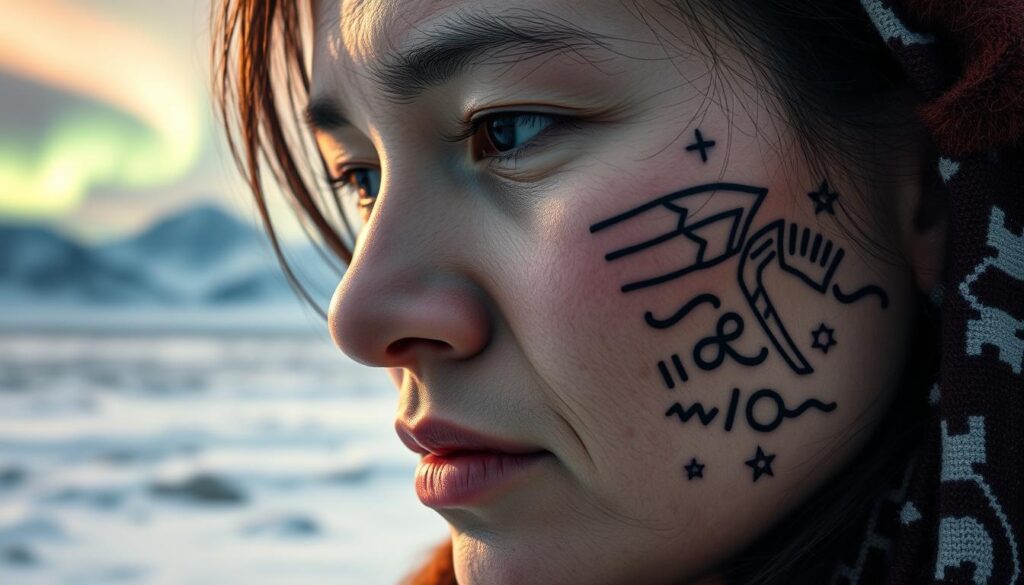
What Are Kakiniit and Tunniit?
Kakiniit and tunniit are two forms of tattoos that were integral to Inuit culture. Kakiniit refer to tattoos done on the body, while tunniit are facial tattoos. These tattoos served various symbolic purposes, including marking important life transitions and signifying cultural identity. For Inuit women, facial tattooing was a significant rite of passage, marking their transition into womanhood.
The Role of Tattoos in Inuit Society
Tattoos played a crucial role in Inuit society, particularly for women. The practice of facial tattooing was a prerequisite for marriage, indicating that a woman had acquired the necessary skills for survival and household management in the harsh Arctic environment. These tattoos also served as social indicators, communicating a person’s status, accomplishments, and role within the community. By wearing these tattoos, individuals reinforced their cultural identity and the values of their society.
The significance of tattoos in Inuit culture extends beyond personal adornment, representing a connection to their heritage and the community’s collective identity. Through these tattoos, the Inuit people preserved their cultural traditions and passed them down to future generations.
The Historical Significance of Inuit Tattoos
Inuit tattoos have a rich history that spans across the Arctic regions, deeply rooted in the cultural and spiritual practices of the Inuit people. The tradition of tattooing was widespread and remained largely unchanged prior to colonization.
Origins and Archaeological Evidence
The origins of Inuit tattoos are not well-documented, but archaeological evidence suggests that tattooing has been a part of Inuit culture for centuries. The practice was not only a form of personal expression but also served various purposes, including medicinal functions similar to acupuncture, pain relief, beautification, and spiritual protection. These tattoos were integral to the Inuit way of life, connecting individuals to their ancestors and the spirit world.
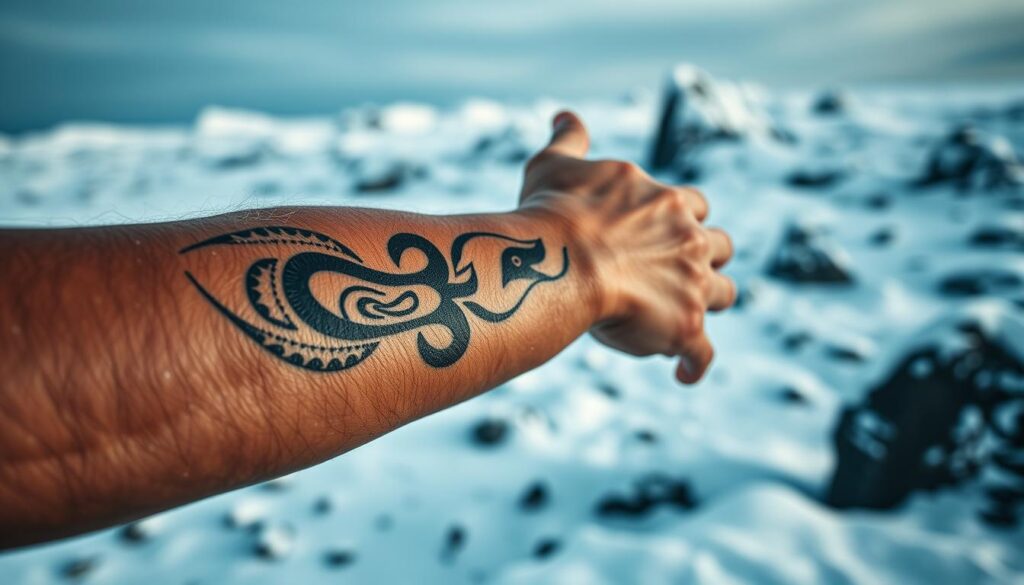
Pre-Colonial Prevalence Across the Arctic
Before European colonization, tattooing traditions existed throughout Inuit territories from Alaska to Greenland, with regional variations in patterns and techniques. The people of these regions had unique designs that reflected their cultural identities and spiritual beliefs. Among Inuit women, tattoos were particularly significant, often symbolizing status, skill, and life experiences.
The introduction of Western medicine and fashion led to a decline in the traditional reasons for getting tattoos, and missionary influence further suppressed the practice. Despite this, the historical significance of Inuit tattoos remains an important part of their cultural heritage, reflecting the resilience and richness of Inuit traditions.
Understanding Inuit Tattoo Terminology
Understanding the language of Inuit tattoos is crucial for appreciating their cultural significance. The terminology used to describe these tattoos varies across different Inuit regions, reflecting the diversity of their cultural practices.
Linguistic Distinctions in Terminology
The Proto-Inuit-Yupik root *kaki- means ‘pierce or prick’, which is the etymon for various terms used to describe tattoos across Inuit dialects. For instance, the Iñupiaq (North Alaskan Inuit) use kakinʸɨq to refer to a tattoo, while in Eastern Canadian Inuktitut, it’s known as kakiniq. West Greenlandic Inuit use kakiuʀniʀit for ‘tattoos’, and in Tunumiit (East Greenlandic), the term is kaɣiniq. This root also signifies ‘tattoo’ in Inuvialuktun (Western Canadian Inuktitut).
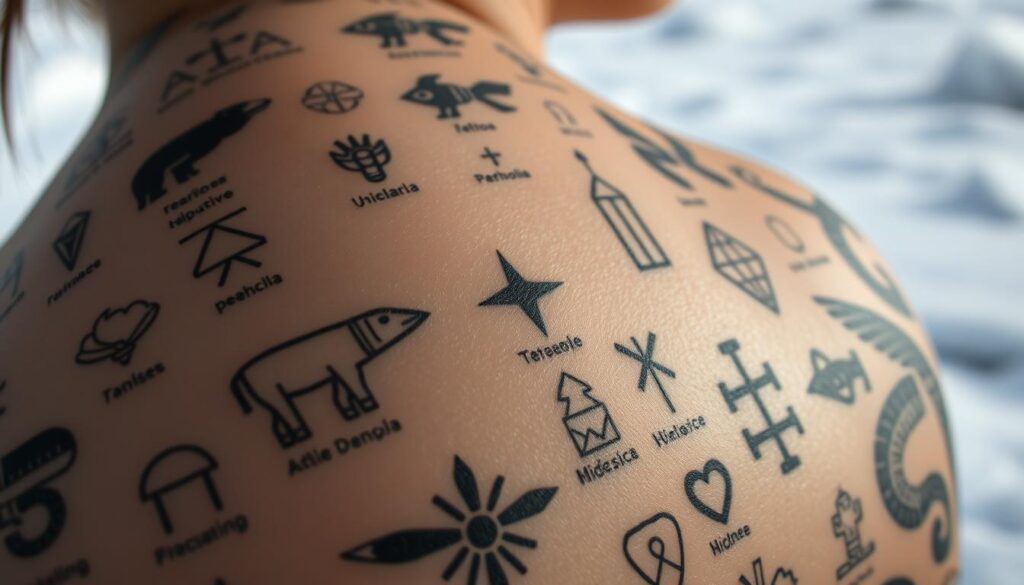
Regional Variations and Cultural Insights
The variation in tattoo terminology not only highlights the linguistic diversity among Inuit communities but also provides insights into their cultural traditions and patterns of interaction. By understanding these regional terms, researchers can trace the movement and evolution of tattooing practices across Inuit territories, shedding light on the cultural connections between these communities despite their geographic separation.
As Dr. Lars Krutak, an anthropologist specializing in tattooing, notes, “Tattoos are not just decorative; they are deeply embedded in the cultural and spiritual fabric of Inuit people.” This emphasizes the importance of understanding the terminology to appreciate the cultural significance of these tattoos fully.
The Spiritual Meaning Behind Inuit Tattoos
Inuit tattoos held deep spiritual significance, connecting the wearer to their mythology and the afterlife. These tattoos were not merely decorative; they played a crucial role in the spiritual lives of the Inuit people.
Connection to Sedna and Inuit Mythology
In Inuit mythology, the goddess Sedna was revered as the ruler of the underworld, Adlivun. According to legend, Sedna controlled the fate of souls in the afterlife. Women who wore traditional Inuit tattoos, known as kakiniit, were believed to be favored by Sedna. The presence of these tattoos was thought to ensure that women could access the afterlife, where they would experience happiness and good things.
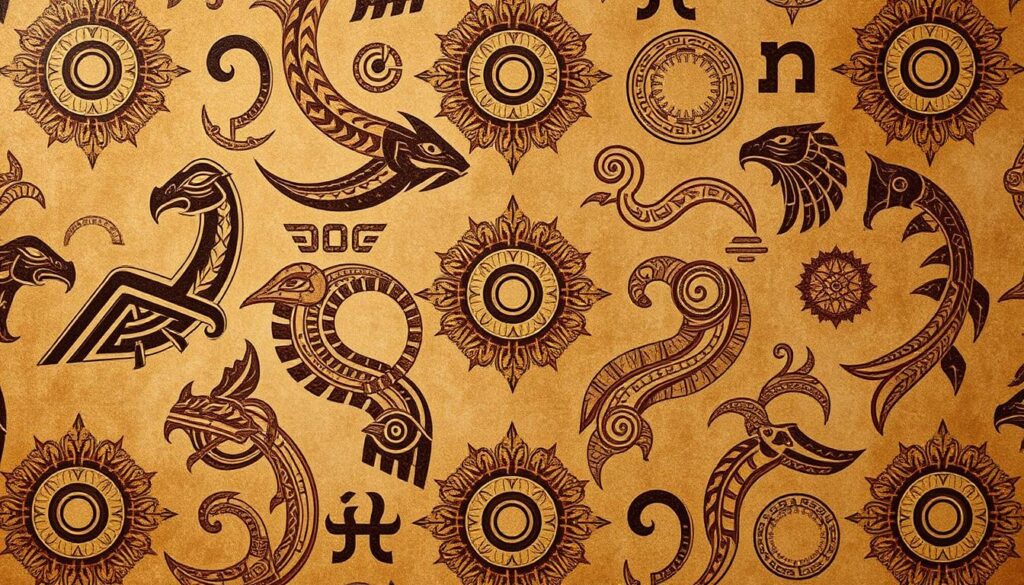
The significance of Sedna in Inuit mythology highlights the importance of tattoos in spiritual practices. Women without hand tattoos were believed to be denied entry to the afterlife by Sedna, while those without facial tattoos were sent to Noqurmiut, the “land of the crestfallen.” In Noqurmiut, women would spend eternity with smoke coming from their throats and their heads hanging downwards, a fate considered worse than death.
Tattoos as Spiritual Protection and Afterlife Passage
Inuit tattoos served as a form of spiritual protection, safeguarding the wearer not just in life but also in death and the afterlife. The belief was that these tattoos would facilitate a smooth transition into the afterlife, protecting the individual from adverse spiritual forces. This spiritual insurance was crucial for the well-being of the wearer, making tattoos a vital aspect of Inuit spiritual practices.
| Spiritual Aspect | Description | Significance |
|---|---|---|
| Connection to Sedna | Belief that Sedna controls the afterlife | Ensures favorable afterlife |
| Tattoos as Protection | Spiritual protection for the wearer | Safeguards in life, death, and afterlife |
| Afterlife Passage | Facilitates smooth transition | Prevents adverse spiritual consequences |
The cultural importance of receiving traditional tattoos was reinforced by these spiritual beliefs, making them not just socially but spiritually necessary. The practice of tattooing was thus deeply intertwined with the spiritual fabric of Inuit society, reflecting a profound connection between the physical and spiritual worlds.
Traditional Designs and Their Symbolism
Traditional Inuit tattoos are more than just decorative; they are imbued with cultural and spiritual significance. These tattoos are not merely aesthetic expressions but carry deep meanings related to identity, status, and spiritual beliefs.
Facial Patterns and Their Meanings
Facial tattoos in Inuit culture were significant, often denoting status, strength, and beauty. The patterns applied to the face were unique and held various meanings depending on the region and the individual’s status within the community. For a woman, facial tattoos could signify marriageability and spiritual power.
Arm and Hand Designs
Tattoos on the arms and hands were common among Inuit people. These designs often symbolized skill, status, and protection. For instance, a hunter might have tattoos on his arms to signify his prowess and to offer spiritual protection during hunts. The tattoo designs on the hands and arms were typically intricate, reflecting the individual’s achievements and roles within the community.
Chest and Thigh Tattoos
Chest tattoos, particularly for women, were given after childbirth, symbolizing motherhood and fertility. These tattoos often resembled the shape of an amauti, the traditional baby-carrying parka, symbolically connecting the woman to her maternal role. Thigh tattoos, while less visible, held important symbolic meanings related to a woman’s reproductive capacity. The designs on the thighs and chest were part of a complete symbolic system that marked a woman’s body throughout her life journey, signifying various life stages and roles.
The application of these tattoos involved puncturing the skin with needles and inserting soot or other materials to create the designs. This process was not only about aesthetics but also about signifying important life events and statuses, such as having children. The tattoos served as a visual narrative of an individual’s life, experiences, and roles within the Inuit society.
Regional Variations in Inuit Tattoo Designs
Tattoo practices among Inuit groups showed remarkable diversity, with regional variations reflecting broader cultural differences. Inuit communities across the Arctic developed unique tattoo traditions influenced by local customs, environments, and historical contexts.
Greenlandic Traditions
In Greenland, Inuit tattoos were an integral part of the cultural heritage. Traditional Greenlandic tattoo designs often featured intricate patterns that symbolized spiritual connections and life transitions. These tattoos were typically applied to women, signifying their status and identity within the community.
Canadian Arctic Styles
The Canadian Arctic region exhibited its own distinct tattoo styles, often characterized by bold lines and symbolic motifs. Inuit women in this region wore tattoos that represented their connection to the land, spirits, and their community. The patterns used were often passed down through generations, maintaining cultural continuity.
Alaskan Inuit Patterns
Alaskan Inuit groups, including the Iñupiat and Yup’ik peoples, developed unique tattoo traditions that incorporated naturalistic elements and asymmetrical patterns. The Tupik Mi traditional tattoo revitalization project, founded in part by Maya Sialuk Jacobsen, has worked to document and revive these distinctive Alaskan designs. Alaskan Inuit tattoos were influenced by neighboring Indigenous groups while maintaining their distinct Inuit characteristics.
| Region | Tattoo Characteristics | Cultural Significance |
|---|---|---|
| Greenland | Intricate patterns, symbolic designs | Spiritual connections, life transitions |
| Canadian Arctic | Bold lines, symbolic motifs | Connection to land, spirits, community |
| Alaskan Inuit | Naturalistic elements, asymmetrical patterns | Influenced by neighboring groups, distinct Inuit identity |
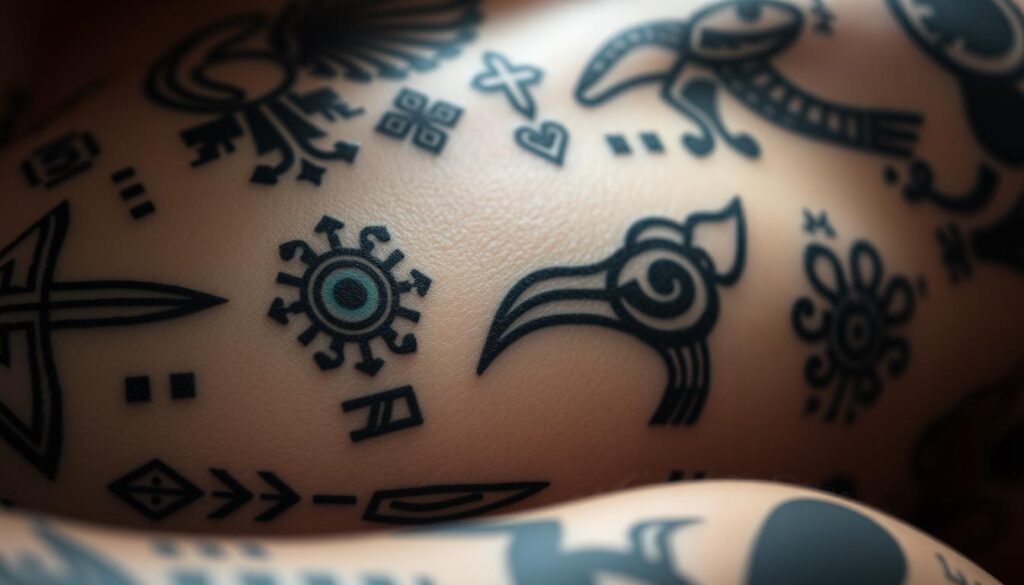
The regional variations in Inuit tattoo designs not only highlight the diversity of cultural practices across the Arctic but also underscore the adaptability and resilience of Inuit traditions in the face of changing environments and social contexts.
The Traditional Tattooing Process
For centuries, Inuit communities have employed unique methods to create meaningful tattoos. The traditional tattooing process is a testament to the ingenuity and cultural richness of Inuit society.
Tools and Materials Used
Traditional Inuit tattooing relied on simple yet effective tools. Tattooists, typically older women with experience in embroidery, used needles and threads to create the designs. The materials used were often readily available in their environment, such as caribou sinew for thread and soot or other natural substances for ink.
The use of these traditional materials highlights the resourcefulness of Inuit people. The needles were often made from bone or stone, demonstrating the adaptability of Inuit technology.
Techniques: Skin-Stitching and Hand-Poking
There were two primary techniques used in traditional Inuit tattooing: skin-stitching and hand-poking. Skin-stitching involved sewing a needle and thread dipped in ink through the skin, leaving a mark that darkened as it healed. This method was not only used for tattooing but also reflected the embroidery skills of the tattooists.
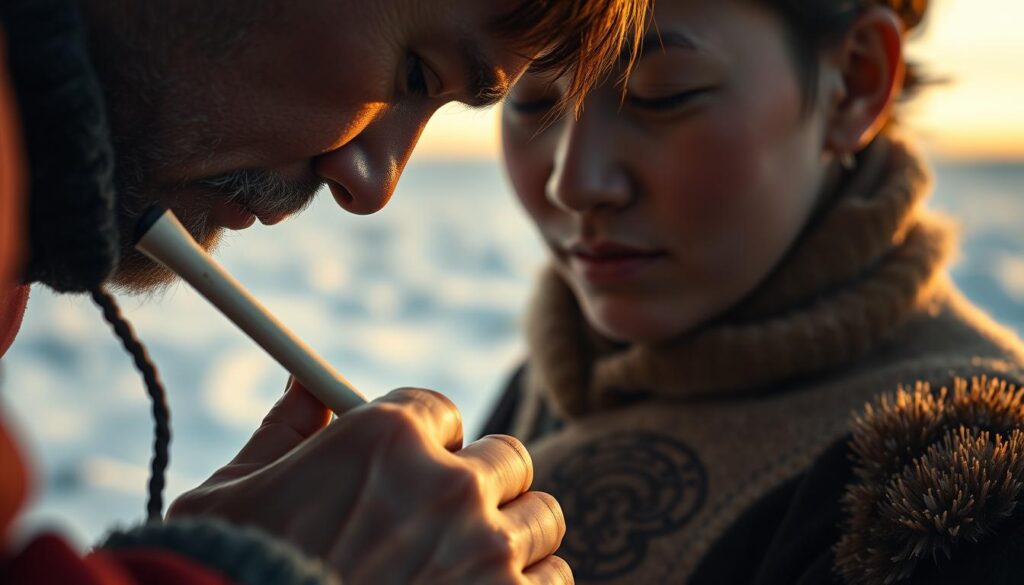
Hand-poking, on the other hand, involved repeatedly puncturing the skin with a needle dipped in ink to create patterns one dot at a time. This labor-intensive process required great skill and patience. Both techniques were passed down through generations, preserving the cultural heritage of Inuit tattooing.
The traditional tattooing process was not just about creating art; it was a ritual that connected the individual to their community and cultural history. The techniques used in Inuit tattooing are a testament to the community’s resilience and creativity.
The Cultural Significance of Inuit Tattoos
Inuit tattoos were an integral part of Inuit culture, representing various life aspects and achievements. These tattoos were not merely decorative; they carried deep symbolic meanings that played a crucial role in identifying and celebrating an individual’s life journey, skills, and status within the community.
Marking Life Transitions and Womanhood
Inuit tattoos often commemorated significant life events and transitions, particularly for women. Specific tattoo designs were used to mark important milestones such as coming of age, marriage, and childbirth. These tattoos served as visual narratives of a woman’s life journey, signifying her role and status within the community. For instance, certain patterns might indicate a woman’s proficiency in traditional skills like sewing or food preparation, which were essential for the community’s survival.
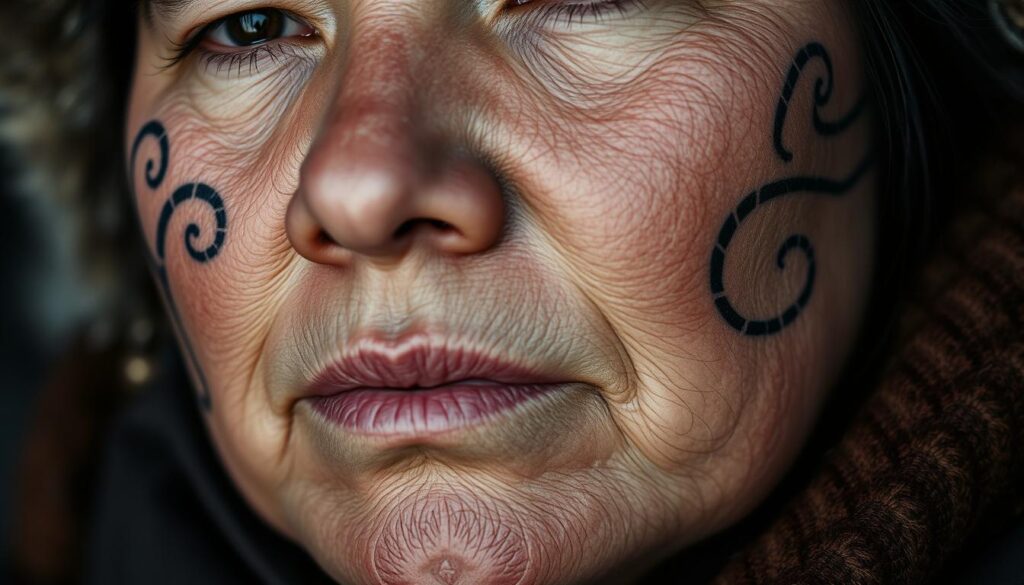
Symbols of Skill, Status, and Identity
Beyond marking life transitions, Inuit tattoos were also symbols of an individual’s skills, social status, and cultural identity. The designs and patterns used in these tattoos communicated important information about the wearer’s capabilities and achievements. For example, more intricate or elaborate tattoos might signify higher status or exceptional skills, such as hunting prowess or spiritual knowledge. These tattoos reinforced the wearer’s identity within the community, distinguishing them as individuals with specific roles and responsibilities.
The cultural significance of these tattoos lies in their ability to convey complex information through a visual language, making them a powerful tool for expressing and preserving Inuit cultural heritage.
Gender Aspects of Inuit Tattoos
Inuit tattoos were not just decorative; they held different meanings and significance for men and women in their society. The tradition of tattooing was deeply rooted in the cultural and spiritual practices of the Inuit people, with distinct differences in the designs and purposes of tattoos for men and women.
Women’s Tattoos and Their Significance
Women’s tattoos were more extensive and complex, often symbolizing life transitions, womanhood, and spiritual connections. These tattoos were a rite of passage and played a crucial role in the cultural identity of Inuit women. The designs were intricate, reflecting the woman’s status, skills, and experiences. For instance, tattoos on a woman’s hands and arms could signify her role in the community and her marital status.
Men’s Tattoos: Differences and Purposes
Men’s tattoos, while less extensive, were significant and served purposes similar to amulets, providing spiritual protection during hunting and other dangerous activities. The designs were often simpler but held deep spiritual meaning, protecting the individual from harm. Interestingly, there were cases of men who were raised as females and received tunniit (traditional women’s tattoos), later becoming “second wives” in some communities, highlighting the flexibility in gender roles within Inuit society.
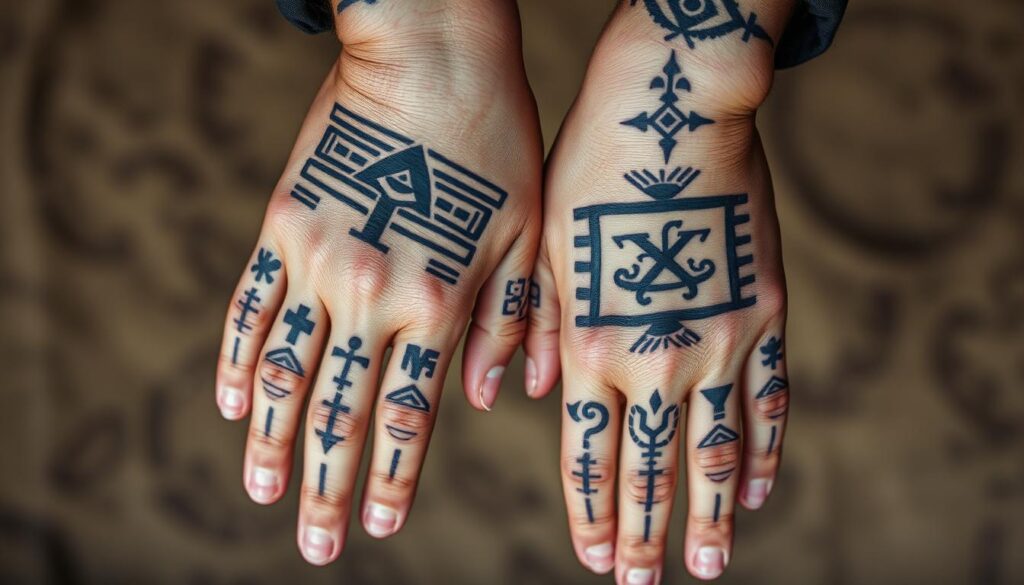
| Aspect | Women’s Tattoos | Men’s Tattoos |
|---|---|---|
| Design Complexity | More intricate and extensive | Simpler and less extensive |
| Purpose | Symbolized life transitions, womanhood, and spiritual connections | Provided spiritual protection during hunting and other activities |
| Significance | Reflected status, skills, and experiences | Served as amulets for protection |
The practice of tattooing in Inuit culture was a gendered practice, reflecting the diverse roles and responsibilities within the community. Understanding these differences is crucial to appreciating the rich cultural heritage of Inuit tattoos.
Colonization and the Suppression of Inuit Tattoos
Colonization brought about a period of significant cultural upheaval for Inuit communities, including the suppression of their tattooing practices. The arrival of missionaries and colonizers had a profound impact on Inuit culture, leading to a decline in the traditional practice of tattooing.
Missionary Influence and Religious Persecution
Missionaries played a crucial role in suppressing Inuit tattooing practices. They viewed tattoos as a sign of “heathenism” and worked to eradicate the practice through religious persecution. Many Inuit were forced to abandon their traditional tattooing practices, and those who continued to practice were often ostracized or punished.
The influence of missionaries was not limited to direct persecution. Their presence also led to a cultural shift away from traditional practices and towards Christianity. This cultural shift was further reinforced by government policies that supported the assimilation of Inuit into Western culture.
The Underground Continuation of Practices
Despite the official bans and missionary pressure, Inuit tattooing practices did not entirely disappear. Instead, they went underground, with many communities continuing to practice in secret. Elders played a crucial role in preserving the knowledge and techniques of traditional tattooing, passing them down to younger generations in private.
The underground continuation of Inuit tattooing practices was a testament to the resilience of Inuit culture. It allowed the tradition to survive, even in the face of significant suppression. Today, this preserved knowledge is being used to revive and reclaim Inuit tattooing practices, ensuring their continuation for future generations.
In many ways, the suppression of Inuit tattoos during the colonization period ultimately strengthened the community’s resolve to preserve their cultural heritage. The practice, though forced into secrecy, remained a vital part of Inuit identity and continues to be celebrated today.
The Revival of Traditional Inuit Tattoos
Efforts to revive traditional Inuit tattoos have gained momentum, driven by key organizations and individuals. The cultural significance of these tattoos has been preserved through various documentation and preservation efforts, ensuring that the knowledge and practices of the ancestors are not lost.
Key Organizations and Individuals in the Revival Movement
The revival of Inuit tattoos is attributed to the work of several key organizations and individuals. Inuk filmmaker Alethea Arnaquq-Baril’s 2010 film, Tunniit: Retracing the Lines of Inuit Tattoos, played a crucial role in documenting the history behind the practice. Arnaquq-Baril interviewed 58 elders representing 10 Inuit communities, providing valuable insights into the traditional designs, techniques, and meanings behind Inuit tattoos. This documentary work has been instrumental in the revival process, serving as a resource for contemporary tattoo artists seeking to revive authentic traditional designs.
Other organizations and researchers have also contributed significantly to the documentation and preservation efforts. By working closely with elders, they have been able to record and analyze traditional tattoo practices, thereby preserving the cultural heritage for future generations.
“Tattoos are not just decorative; they carry deep cultural and spiritual significance. They are a connection to our ancestors and our history.” – An Inuit elder
Documentation and Preservation Efforts
The documentation and preservation efforts have been multifaceted, involving historical photographs, ethnographic accounts, and archaeological evidence. These resources have been used to reconstruct traditional patterns and practices, providing a comprehensive understanding of Inuit tattooing. The table below summarizes some of the key documentation methods and their significance.
| Documentation Method | Significance |
|---|---|
| Historical Photographs | Provide visual evidence of traditional tattoo designs and practices |
| Ethnographic Accounts | Offer detailed descriptions of tattooing techniques and cultural significance |
| Archaeological Evidence | Help date the origins of tattooing practices and identify regional variations |
These efforts not only serve scholarly purposes but also provide practical resources for contemporary tattoo artists. By understanding the traditional ways of tattooing, artists can create designs that are authentic and meaningful, helping to keep the cultural heritage alive.
The revival of traditional Inuit tattoos is a testament to the resilience of Inuit culture and the importance of preserving cultural heritage. Through the combined efforts of individuals, organizations, and communities, the knowledge and practices of the elders and ancestors are being kept alive, ensuring that future generations can continue to appreciate and practice this significant aspect of Inuit identity.
Modern Inuit Tattoo Practices
Modern Inuit tattoo practices are not only a means of personal expression but also a way to visibly reclaim and celebrate Inuit identity. The resurgence of traditional tattooing has become a significant aspect of cultural revitalization among Inuit communities.
Traditional vs. Contemporary Methods
The methods used in modern Inuit tattoo practices vary, with some artists adhering to traditional techniques while others incorporate contemporary methods. Traditional tattooing involved using tools made from bone or stone to puncture the skin and insert ink made from soot or other natural materials. In contrast, contemporary methods often utilize modern tattoo equipment, making the process more accessible while still honoring the traditional designs.
Cultural Reclamation Through Tattooing
The act of receiving a traditional tattoo has become an act of resistance against colonial suppression and a means to reclaim Inuit culture and pride. Many modern wearers, including prominent figures such as Celina Kalluk, Lucie Idlout, and Member of Parliament Mumilaaq Qaqqaq, bear traditional tattoos as a public statement about their connection to their ancestors and their people. These tattoos serve not just as personal adornment but as symbols of resilience and cultural continuity.
As Inuit communities continue to heal from historical trauma, the practice of traditional tattooing plays a crucial role in cultural reclamation, allowing individuals to reconnect with their heritage and assert their identity.
Prominent Figures Wearing Inuit Tattoos Today
The resurgence of Inuit tattoos is evident in the growing number of prominent figures embracing this traditional practice. These individuals are not only wearing their cultural heritage on their sleeves but are also using their visibility to promote Inuit identity and pride.
Artists and Cultural Leaders
Many artists and cultural leaders have taken to wearing Inuit tattoos as a way to connect with their heritage and express their cultural identity. These individuals are often at the forefront of cultural revitalization efforts, using their art and public presence to share Inuit traditions with a wider audience. For instance, a notable Inuit artist might wear traditional tattoos as a symbol of pride in their cultural roots, inspiring others to explore and appreciate their own heritage.
| Name | Profession | Notable Work |
|---|---|---|
| Alethea Arnaquq-Baril | Filmmaker | Documenting Inuit traditions |
| Kenojuak Asatanna | Artist | Inuit prints and sculptures |
Political Figures and Activists
Political figures and activists are also embracing Inuit tattoos, using their public platforms to bring attention to Inuit issues and cultural heritage. A prominent example is Mumilaaq Qaqqaq, who was elected as a Member of Parliament in 2019 representing Nunavut and proudly wore traditional facial tattoos. Such visible displays of cultural identity in political spaces mark a significant shift from the historical suppression of Inuit practices. These individuals use their tattoos as a form of identity and a conversation starter to educate others about Inuit history and contemporary challenges.
As more people like Mumilaaq Qaqqaq take on leadership roles, the presence of Inuit tattoos in these spaces serves as a powerful statement of cultural pride and a reminder of the importance of preserving Indigenous traditions. At the same time, it reflects a broader movement towards reconciliation and recognition of Inuit culture.
The Global Recognition of Inuit Tattoos
The practice of Inuit tattooing has seen a resurgence in global popularity, largely due to cultural revitalization efforts and increased awareness. As a result, Inuit tattoos are now recognized and appreciated worldwide for their cultural significance and beauty.
Representation in Media and Art
Inuit tattoos have been featured in various media and art forms, showcasing their unique designs and cultural importance. Museum exhibitions have played a significant role in promoting Inuit tattoo traditions, providing a platform for Inuit artists to share their work. For instance, exhibitions have highlighted the intricate designs and the stories behind them, educating the public about the cultural context of these tattoos.
| Medium | Description | Impact |
|---|---|---|
| Museum Exhibitions | Showcasing Inuit tattoo art and cultural significance | Educates the public and promotes cultural understanding |
| Documentaries | Featuring Inuit tattoo artists and their stories | Raises awareness about Inuit tattoo traditions |
Educational Initiatives and Cultural Exchange
Educational initiatives have been instrumental in promoting the understanding and appreciation of Inuit tattoos. University courses and community workshops have been developed to teach about the history and significance of Inuit tattoos. Furthermore, Inuit tattoo artists have participated in international tattoo conventions, sharing their traditions with broader audiences and fostering cultural exchange.
These efforts have not only helped in preserving the cultural heritage of Inuit tattoos but have also combated cultural appropriation by promoting respectful appreciation.
Conclusion: The Enduring Legacy of Inuit Tattoos
The story of Inuit tattoos is one of resilience and cultural persistence. For centuries, these tattoos have been a vital part of Inuit identity, symbolizing cultural heritage and spiritual connection. Despite historical suppression and cultural erasure, Inuit tattoos have survived, and their significance is being reclaimed today.
The revival of traditional Inuit tattoo practices is not just about aesthetic recovery; it’s a journey of healing from historical trauma and reclamation of cultural identity. These tattoos create a living connection between contemporary Inuit people and their ancestors, securing cultural knowledge for future generations.
Inuit tattoos have transformed from symbols of oppression to powerful symbols of cultural pride and resilience. They adorn the faces and bodies of Inuit people, visible symbols of a culture that refuses to be erased. The story of Inuit tattoos offers important lessons about cultural persistence, adaptation, and the power of traditional practices to sustain identity across generations.
As we look to the future, it’s clear that Inuit tattoos will continue to play a vital role in the lives of Inuit children and communities for years to come. They represent a living tradition that continues to evolve while maintaining its core cultural significance. Today, Inuit tattoos are a testament to the strength and resilience of the Inuit people, a culture that thrives in the modern world.
